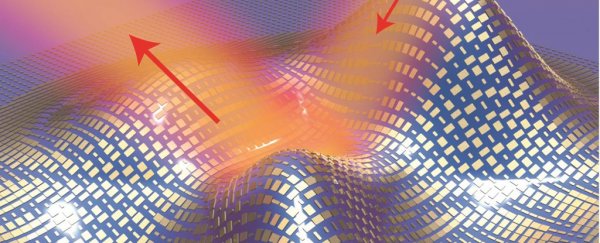Invisibility cloaks are a staple of fantasy and science fiction, but they're also an ongoing field of interest to scientific researchers, who are continually working on ways to manipulate how objects interact with light to see if we can make things that are really there look as if they're not.
Now a new development may be the biggest advancement in real-world invisibility cloaks yet, with researchers led by Berkeley Lab in the US developing an ultra-thin invisibility 'skin' cloak that can wrap around a 3D object and hide it from detection via visible light.
The cloak, which at present is only capable of making microscopic objects invisible, is composed of an extremely thin layer of gold nanoantennae that form a tiled coat only 80 nanometres thick. At its current dimensions, it can be draped over very small objects the size of a few biological cells (1,300 square microns in area), and when done so, manages to mask their 3D shape by reflecting light waves.
"This is the first time a 3D object of arbitrary shape has been cloaked from visible light," said Xiang Zhang, director of Berkeley Lab's Materials Sciences Division, in a press release. "Our ultra-thin cloak now looks like a coat. It is easy to design and implement, and is potentially scalable for hiding macroscopic objects."
The cloak works by employing specially devised metamaterials, which unlike natural materials can bend or curve the reflection of light via their physical structure rather than their chemical composition, essentially rendering objects optically undetectable. When light falls on the activated cloak, its array of nanoantennae distort the usual reflection of light from the object underneath, which makes it seem as if nothing is there.
The cloak, which is described in the journal Science, makes an object appear flat and invisible if viewed from in front, but any movement by the viewer or the object would shatter the illusion – so it's no Harry Potter cloak just yet.
Previous efforts by the researchers were able to make objects hidden, but the cloak itself could still be seen. Further, their physical bulk made the invisibility cloaks impractical for all but microscopic purposes. "If you wanted to cloak your body, you'd have to carry this thing that's three to four times the size of your body around with you wherever you go," Zhang told Ian Sample at The Guardian.
However, advancements in metamaterial layers have now resulted in the first real invisibility cloak technology that could be scaled up to hide actual people (as long as everybody stands perfectly still, that is).
"It's the first time we've done arbitrary shape cloaking," said Zhang. "If you want to cloak people, that is possible with this new work."
